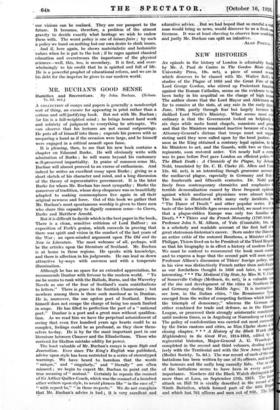NEW HISTORIES
AN episode in the history of London is admirably ha by Mr. J. Paul de Castro in The Gordon Riots (Oxf University Press, 18s. net), a piece of sound re which deserves to be classed with Mr. Walter Belk studies of the Plague of 1665 and the Great Fire of I Lord George Gordon, who stirred up Protestant fanati against the Roman Catholics, seems on the evidence to been lucky in his acquittal on the charge of high tr The author shows that the Lord Mayor and Aldermen far to connive at the riots, at any, rate in the early day; June, 1780, partly through fear but largely because ; disliked Lord North's Ministry. What seems most e ordinary is that the Government looked on helplessly six days while mobs burnt chapels, mansions and pri and that the Ministers remained inactive because of a fo Attorney-General's dictum that troops must not supp rioting until they were called upon by the local justices. soon as the King obtained a contrary legal opinion, he his Ministers to act, and the Guards, with two or three regiments, soon restored order. Yet nearly half a een was to pass before Peel gave London an efficient police. ts The Black Death : A Chronicle of the Plague, by John Nohl, translated by Dr. C. H. Clarke (G. Allen and l's 12s. 6d. net), is an interesting though gruesome account the mediaeval plague, especially in Germany and Italy the fourteenth and fifteenth centuries. Dr. Nohl go freely from contemporary chronicles and emphasizes terrible demoralization caused by these frequent epide against which mediaeval physicians were almost he The book is illustrated with many early incidents, " The Dance of Death " and other popular series. If taste of the later Middle Ages seems morbid, we must remem that a plague-ridden Europe was only too familiar Death. * * * Thiers and the French- Monarchy (1797-1848) Professor John S. M. Allison, of Yale (Constable, 18s. is a scholarly and readable account of the first half of great statesman-historian's career. :Born under the Direct an active critic of the restored Boinbons, a Minister of Philippe, Thiers lived on to be President of the Third Reps so that his biography is in. effect &history of modern F We must be content to recommend the book most cord and to express a hope that the second part will soon ap Professor Allison's discussion of Thiers' foreign policy, W in his view was distinctively French rather .than anti-Eng as our forefathers thought in 1886 and later, is espee interesting. * * * The Medieval .City State, by Miss M. V. Cla of Somerville College (Methuen, 6s. net), is a valuable st of the rise and development of the cities in Northern and Germany during the Middle Ages. ' It is instructive see how, in the Malian cities, " the Renaissance Ty emerged from the welter of competing factions which folio the triumph of democracy," whereas the German e either combined for trade and defence, as in the Ha League, or preserved their strongly aristocratic constitu until modern times, as in Augsburg or Nuremberg or Co The policy of confederation was carried out most successf by the Swiss cantons and cities, as Mis,s :Clarke shows in closing chapter. * * * A History of the Black Watch Highlanders) in the Great War, 1914-1918, edited by regimental historian, Major-General A. G. Wauchope, completed in the second and third volumes, dealing revett ively with the Territorial and with the New Army ha (Medici Society. 75. 6d.). The war record of each of the battalions has been written by one of its officers, and mei the honours and the sadly long casualty lists. One or of the battalions seems to have been in every action importance. Nowhere did the Black Watch distinguish more than at Loos, on September 25th, 1915. The attack on Hill 70 is vividly described in the record of Ninth Battalion, which formed part of the 44th 13
and which lost 701 officers and men out of 940,_ ..... spent many months in Macedonia, the Sixth was on the Somme and in the desperate struggle round Rheims in July, 1918, the Seventh distinguished itself at the Somme, and so on. Regimental histories perhaps give the civilian reader a truer idea of modern war than do the general surveys of the conflict ; at any rate, these well-edited volumes, with their maps and photographs, will interest the many who had fathers, sons or brothers in the fine old regiment, The editor states that 30,000 men served in the various battalions and that 8,000 fell.























































 Previous page
Previous page